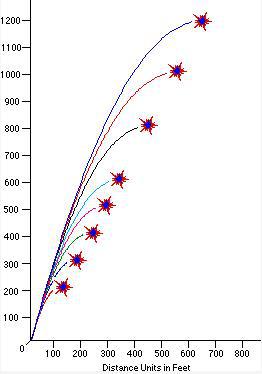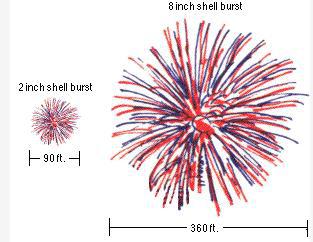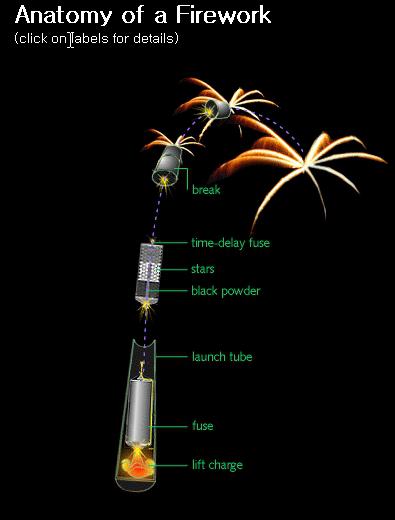Simple facts behind the fireworks~

그런데.. Do you know what makes fireworks WORK?
한번 생각해 보신 적 있는지요-
다 아는 이야기일지도 모르지만, 혹시나 궁금한 사람들을 위해 몇가지 소개합니다~^^
짙은 밤하늘을 배경으로 화려한 불꽃들을 장식하는 순간의 스펙타클 쇼를 위해--
Pyrotechnician들은 미리 구상한 계획에 필요한 계산을 합니다
물리학이라고 하기는 너무 거창하고-, 여러 가지 크기의 불꽃을 어느 위치에서 연출할 것인지를 결정하는데 적용되는 간단한 원리를 소개하겠습니다.
추진 화약(금속이온, 산화제, 환원제 등의 혼합물)을 정해진 지름과 높이가 있는 Shell(원통)에 넣고, 일정한 각도로 조준하여 불을 붙이게 됩니다.
이 때,
"사용되는 원통(shell)크기와 화약의 양에 따라 초기속도(initial velocity)를 조정하는데,
화약이 든 원통은 중력의 영향을 받으면서 수직 상승하고,
조준한 각도가 있으므로 수평 이동을 동시에 하게 되므로,
최종적으로 불꽃이 터지는 위치는 점화시켜 출발하는 순간의 수직상승속도(초기속도)와 출발 후 하 늘에 채류하는 시간을 알 때, 피타고라스정리, 삼각함수의 간단한 공식으로 구합니다"
[#M_Click to see the Details..|Close.|
The relationships between the initial velocities and the distances traveled by the shells can be understood and manipulated by using the following formulas and mathematical methods:
- 1. Y=VyT+0.5GT^2 (* T^2는 T의 제곱)
- Y=vertical height, Vy=initial vertical velocity, T=hang time, G=acceleration due to gravity
-
- * 수직 상승의 속도는 중력에 반비례하여 감소.
- * 수직 상승의 속도는 중력에 반비례하여 감소.
- 2. X=VxT
- 2. X=VxT
- X=horizontal distance, Vx=initial horizontal velocity, T=hang time
- X=horizontal distance, Vx=initial horizontal velocity, T=hang time
- * 수평이동 속도
- 3. The Pythagorean Theorem - a^2 + b^2 = c^2
- a or b = vertical or horizontal velocity, c=resultant initial velocity
- a or b = vertical or horizontal velocity, c=resultant initial velocity
- * 피타고라스 정리, 꼭지점 c가 최종 burst 지점
- 4. The Trigonometric Functions(삼각함수) - sine, cosine, and tangent
- In a right triangle sine=opposite side/hypotenuse, cosine=adjacent side/hypotenuse, tangent=opposite side/adjacent side
- In a right triangle sine=opposite side/hypotenuse, cosine=adjacent side/hypotenuse, tangent=opposite side/adjacent side
Reference source > http://library.thinkquest.org/15384/physics/index.htm
Shell의 지름이 다른 종류 여러 개(2inch ~ 12inch)를 같은 각도(75 degree)로 쏘았을 때를 예를 보면.. 한눈에 들어오네요^^

[#M_Click to compare actual sizes..|Close.|
 2인치 shell에 담은 것은 90피트, 30m정도 직경의 불꽃, 8인치 shell은 120m직경의 불꽃을 만들게 되네요_M#]
2인치 shell에 담은 것은 90피트, 30m정도 직경의 불꽃, 8인치 shell은 120m직경의 불꽃을 만들게 되네요_M#]물론, 불꽃의 위치 뿐 아니라 모양과 터지는 시간 등도 고려를 하게 되는데, Shell 내에 화약(Black powder/Gun powder)와 함께 Time-delay fuse가 있어 최종 불꽃이 터지는 시간을 조정한다고 합니다.
[#M_International Visitors Click -|Close.|Reference source > http://library.thinkquest.org/15384/physics/index.htm
Most people don't realize the vast world of physics that takes place during every fireworks show. The science of pyrotechnics involves many physics applications that must be considered to produce entertaining displays. Pyrotechnicicans must take into account the relationships between vectors, velocities, projectiles and their trajectories, the explosion forces behind burst patterns, etc.
The relationships between the initial velocities and the distances traveled by the shells can be understood and manipulated by using the following formulas and mathematical methods:
- Y=VyT+0.5GT^2
- Y=vertical height, Vy=initial vertical velocity, T=hang time, G=acceleration due to gravity
- X=VxT
- X=horizontal distance, Vx=initial horizontal velocity, T=hang time
- The Pythagorean Theorem - a^2 + b^2 = c^2
- a or b = vertical or horizontal velocity, c=resultant initial velocity
- The Trigonometric Functions - sine, cosine, and tangent
- In a right triangle sine=opposite side/hypotenuse, cosine=adjacent side/hypotenuse, tangent=opposite side/adjacent side
2"- 12" Shell Trajectories Fired at 75 Degrees
 The first two formulas you see are primarily used to chart trajectories like in the graph on the left that shows the flight paths of 2" through 12" shells fired at 75 degrees. These graphs are very useful tools that allow pyrotechnicians to visualize how high and how far their shells will travel during a show. This information can be used to aid the process of choreographing the show to music, and determining if some shells will exceed the safe zone for that particular site. The Pythagorean Theorem is used to find a certain initial velocity value if the other two are known. This is helpful in determining information needed for the other formulas. The Trigonometric Functions are also used to find initial velocity values, but are used to find vertical heights, horizontal distances, and firing angles as well. Pyrotechnicians use these mathematical methods along with charts, graphs, and computer programs derived from them to plan their impressive displays.
The first two formulas you see are primarily used to chart trajectories like in the graph on the left that shows the flight paths of 2" through 12" shells fired at 75 degrees. These graphs are very useful tools that allow pyrotechnicians to visualize how high and how far their shells will travel during a show. This information can be used to aid the process of choreographing the show to music, and determining if some shells will exceed the safe zone for that particular site. The Pythagorean Theorem is used to find a certain initial velocity value if the other two are known. This is helpful in determining information needed for the other formulas. The Trigonometric Functions are also used to find initial velocity values, but are used to find vertical heights, horizontal distances, and firing angles as well. Pyrotechnicians use these mathematical methods along with charts, graphs, and computer programs derived from them to plan their impressive displays.

Pyrotechnicians must also consider shell burst sizes when planning shows. They must know how big certain bursts are when compared to others so that the choreographing of the show is in sync and so they don't exceed their safe zone requirements. As with initial mortar velocities, the bigger the shell size the larger the effect. It follows the same principle in that larger shells contain greater amounts of chemicals that when ignited produce greater explosion forces than do smaller shells. This results in varied burst sizes. Shell burst sizes are usually about 45 feet in diameter for every inch in shell size, depending on how tightly the shell is packed. As you can see in the diagram on the right, the differences in burst sizes can be extremely huge. It is just one more thing that pyrotechnicians must take into account to produce entertaining and attractive fireworks shows.
Pyrotechnicians must master many different types of science in order to create attractive displays.
Reference source > http://library.thinkquest.org/15384/physics/index.htm
사용되는 화약(Black powder/Gun powder)에는 산화제(Oxidizers), 환원제(Reducing Agent), Coloring Agent(금속이온 포함하는 연소시 발색물질), 고착제(Binders and regulators)가 혼합되어 있습니다.
1. 산화제(Oxidizer) : N(give up 1/3 of O2) 혹은 Cl(give up all of O2) 포함, O2를 생성
2. 환원제(R.agent) : S 혹은 C를 포함, 산소와 반응하여 SO2, CO2를 만들며 Hot gass를 produce. 반응속도 조절(Regulator/Speeding or Slowing).
3. Coloring Agent : 불꽃반응에 쓰이는 금속이온~포함[#M_Click to see more..|Close.|
| Color | Compound |
|---|---|
| Red | strontium salts, lithium salts lithium carbonate, Li2CO3 = red strontium carbonate, SrCO3 = bright red |
| Orange | calcium salts calcium chloride, CaCl2 calcium sulfate, CaSO4·xH2O, where x = 0,2,3,5 |
| Gold | incandescence of iron (with carbon), charcoal, or lampblack |
| Yellow | sodium compounds sodium nitrate, NaNO3 cryolite, Na3AlF6 |
| Electric White | white-hot metal, such as magnesium or aluminum barium oxide, BaO |
| Green | barium compounds + chlorine producer barium chloride, BaCl+ = bright green |
| Blue | copper compounds + chlorine producer copper acetoarsenite (Paris Green), Cu3As2O3Cu(C2H3O2)2 = blue copper (I) chloride, CuCl = turquoise blue |
| Purple | mixture of strontium (red) and copper (blue) compounds |
| Silver | burning aluminum, titanium, or magnesium powder or flakes |
<주기율표, 표시된 원소들의 역할>
| 1 H | 2 He | ||||||||||||||||
| 3 Li | 4 Be | 5 B | 6 C | 7 N | 8 O | 9 F | 10 Ne | ||||||||||
| 11 Na | 12 Mg | 13 Al | 14 Si | 15 P | 16 S | 17 Cl | 18 Ar | ||||||||||
| 19 K | 20 Ca | 21 Sc | 22 Ti | 23 V | 24 Cr | 25 Mn | 26 Fe | 27 Co | 28 Ni | 29 Cu | 30 Zn | 31 Ga | 32 Ge | 33 As | 34 Se | 35 Br | 36 Kr |
| 37 Rb | 38 Sr | 39 Y | 40 Zr | 41 Nb | 42 Mo | 43 Tc | 44 Ru | 45 Rh | 46 Pd | 47 Ag | 48 Cd | 49 In | 50 Sn | 51 Sb | 52 Te | 53 I | 54 Xe |
| 55 Cs | 56 Ba | 57 La | 72 Hf | 73 Ta | 74 W | 75 Re | 76 Os | 77 Ir | 78 Pt | 79 Au | 80 Hg | 81 Tl | 82 Pb | 83 Bi | 84 Po | 85 At | 86 Rn |
| 87 Fr | 88 Ra | 89 Ac | 104 Rf | 105 Db | 106 Sg | 107 Bh | 108 Hs | 109 Mt | 110 110 | 111 111 | 112 112 |
[#M_International Visitors Click -|Close.|Reference Source > http://library.thinkquest.org/15384/chem/index.htm
Fireworks are usually made out of the following items; an oxidizing agent, a reducing agent, a coloring agent, binders and regulators. These this mixed together are what make up the basic fireworks.
Oxidizers
The first thing in a firework is the oxidizing agent. These produce the Oxygen to burn the mixture. Oxidizers are usually nitrates, chlorates or perchlorates. The common oxidizers are nitrates. These are made up of a metal ion and the nitrate ion. I'll use potassium nitrate as an example. Nitrates only give up 1/3 of their oxygen.

Perchlorates have more oxygen in them, but are less likely to explode if you drop them than are chlorates. Again these are made up of a metal ion and then the perchlorate polyatomic ion. An example of a typical perclorate giving up its oxygen would look something like this, (graphic).
Reducing AgentsThe second elements of fireworks are the reducing agents. The reducing agents burn the oxygen produced by the oxidizers to produce hot gasses. Two examples of reducing agents are Sulfur and Charcoal(carbon). These react with the oxygen to form respectively Sulfur Dioxide and Carbon Dioxide.
Usually two reducing agents are combined. This results in speeding or slowing the reaction. Therefore, the reducing agents are used to control the speed of the reaction. Also, metals are often added to speed the reaction. The finer the powder the faster the reaction. This is because of one of the factors affecting reaction rates, concentration. If you set fire to wheat, it will burn slowly. If you set fire to wheat dust floating in the air, it will explode, this is shown when a grain elevator explodes. Also cornmeal is often used to slow down the reaction. These metals and the cornmeal are the regulators.
Binders
The fourth element of fireworks are the binders. Binders hold the mixture in a lump. This lump is a star. In order to form a star, two main elements are used. These two are dextrine dampened by water, or a shellac compound dampened by alcohol. These are rolled and then cut, or the mixture is forced into a paper tube, and pushed out with a dowel. Then the stars are cut as they come out.
Reference Source > http://library.thinkquest.org/15384/chem/index.htm
_M#]







Add comment